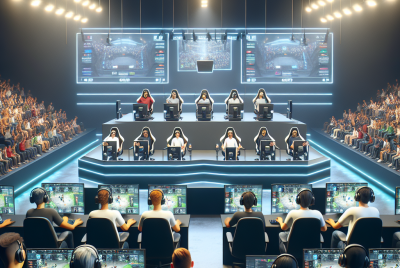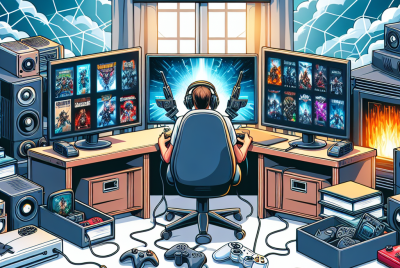Is VR Gaming Accessible for Everyone?
Understanding VR Gaming Accessibility
Virtual Reality (VR) gaming offers an immersive experience that transports players into digital worlds. However, the accessibility of these experiences for all individuals, including those with disabilities, remains a significant concern. Examining how accessible VR gaming is involves analyzing various aspects such as hardware requirements, software design, and sensory barriers.
Hardware Considerations
The hardware used in VR gaming plays a crucial role in determining its accessibility. The typical setup includes a headset, controllers, and often additional sensors for motion tracking. The cost of these devices can be a barrier. High-end VR systems can range from $400 to over $1,000, making them inaccessible to many potential users. Manufacturers such as Oculus, HTC, and Valve have made strides in creating more affordable options, but the fundamental issue of cost remains.
Moreover, the physical compatibility of VR equipment poses challenges for individuals with certain disabilities. Most headsets require a certain amount of physical space for movement, and users with limited mobility or those who use wheelchairs may find navigating the virtual space difficult.
Software and Game Design
Beyond hardware, accessibility in gaming also depends heavily on game and software design. Many developers are beginning to incorporate inclusive design principles but progress is still uneven. Features such as customizable control schemes, adjustable difficulty levels, and visual adjustments can significantly enhance accessibility.
Games like “Beat Saber” allow for adjustments in gameplay speed and music volume, accommodating players with varying abilities. It’s crucial for developers to implement options like one-handed controls or simplified mechanics to cater to users with motor impairments. Designing for accessibility isn’t just about adapting existing games; it involves creating new experiences that prioritize inclusivity from the outset.
Sensory Impairments
VR gaming can be particularly challenging for individuals with sensory impairments. Visual problems can range from color blindness to complete blindness, and developers should consider these factors in their game design. For instance, providing audio cues and haptic feedback can enhance the experience for visually impaired players, helping them navigate virtual environments through sound and touch.
On the other hand, individuals who are hard of hearing may miss out on critical audio elements. Implementing options for subtitles and visual indicators that reflect in-game sounds can help bridge this gap. Developers like Insomniac Games have started embracing inclusive practices, such as providing captioning options in their titles.
Cognitive Accessibility
Cognitive disabilities also play a part in the accessibility debate within gaming. Complex gameplay mechanics and intricate storylines may pose challenges for individuals with cognitive impairments. Simplified controls, guided tutorials, and clear in-game prompts can significantly aid players who might struggle to learn and adapt to traditional gameplay.
VR experiences should also consider pacing, allowing players to take breaks and proceed at their own speed. Games that allow users to familiarize themselves with controls in a safe environment can reduce anxiety and increase confidence, creating a more enjoyable experience.
Community and Support
The VR gaming community’s role in promoting accessibility cannot be overlooked. Platforms that encourage discussions around accessibility can drive awareness and provide important feedback for developers. Events like Global Accessibility Awareness Day spotlight advancements and push for inclusivity, urging developers to prioritize accessibility in their future projects.
Additionally, organizations and advocacy groups advocate for increased representation within the gaming industry. The presence of individuals with disabilities in the development and marketing sectors helps ensure that products meet a wider range of needs, leading to a more diverse portfolio of accessible games.
Technology Advancements
Technological advancements are continuously reshaping the landscape of VR gaming. Eye-tracking technology, for example, can enhance accessibility by allowing players to control elements of the game merely by looking at them. This could offer significant benefits for those with mobility challenges. Similarly, voice recognition technology can provide an alternative control mechanism, making games more accessible to those who have difficulty with traditional input devices.
The Importance of User Testing
User testing with diverse groups, particularly those with disabilities, is vital in creating accessible VR experiences. Developers can gather invaluable insights regarding the usability of their games and identify specific barriers that may exist. Engaging users in the design process can lead to more inclusive outcomes, as their direct experiences can inform the development of more accessible features.
Industry Leadership and Policy
Leadership within the gaming industry plays a significant role in promoting accessibility. Companies investing in inclusive design champion the importance of accessibility, setting a standard for others to follow. Policy changes and industry regulations can also encourage practices that prioritize accessibility, pushing developers to innovate in this space.
Funding and grants for developing accessible technology can help overcome the financial barriers faced by smaller studios. Government support can also incentivize research into creating more inclusive gaming experiences.
Parental and Community Engagement
For younger gamers, parental engagement and community initiatives can encourage interest in accessible VR gaming. Awareness campaigns and educational programs can inform families about available products and adaptations for gamers with disabilities. Community-driven events such as local VR gaming meet-ups can facilitate broader access and exposure to these experiences.
Future of VR Gaming Accessibility
The future of VR gaming accessibility appears promising, provided that ongoing efforts are made to address current limitations. As awareness increases among developers, gamers, and the public, the push for accessible gaming experiences continues to grow. Engagement from users, advocacy groups, and industry leaders creates a collaborative effort to integrate accessibility into VR gaming from the ground up.
In summary, while VR gaming presents exciting opportunities for immersive experiences, it still faces significant hurdles regarding accessibility. Understanding both the hardware and software limitations is essential in shaping a more inclusive gaming environment. Continued advocacy and innovative solutions can pave the way for a future where VR gaming is truly accessible for everyone.




